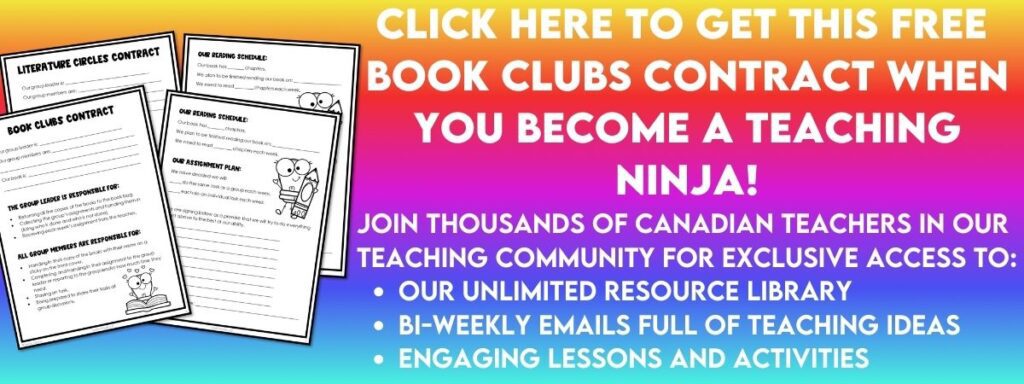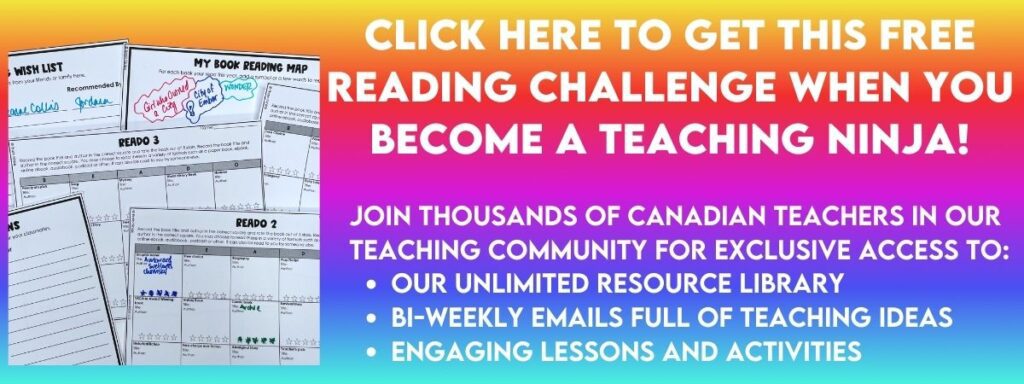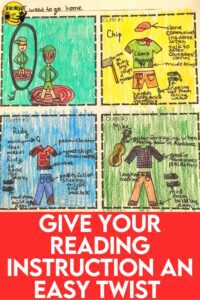
For years we’ve done Literature Circles and tried lots of variations, but this one worked really well with our students. The problem with Literature Circles is that some students just don’t like the different activities. This version allows students to have some independence while still having accountability (and something to show for the time). If you are looking for an activity to spice up your reading instruction, look no further than Twisted Literature Circles.
How Do We Use This Twist on Literature Circles?
We use book clubs or Literature Circles two or three times a year for the whole class. Our students are in grades four and five, so they all can read a novel. We organize the groups of books by levels (usually with a harder one and an easier one in the mix).
Ninja Note: We use book clubs and Literature Circles terms interchangeably. The only difference is the types of assignments we give our students, but the set-up and group discussions are the same no matter what the assignments are.
In Literature Circles, students are traditionally assigned roles within the group to complete for each chapter. Possible roles include summarizer or word wizard (vocabulary). In book clubs, the roles are mixed up and don’t always have a specific role. Students are encouraged to talk about their books more than write. Book clubs are a little “freer” than Literature Circles.
What is the Goal of Literature Circles?
The goal of Literature Circles or book clubs is to teach students to read books in a more natural way–for enjoyment. Getting to read the same book as your friends is something adults do for entertainment, but somehow when we teach reading in the classroom it becomes laborious and no student wants or needs that.
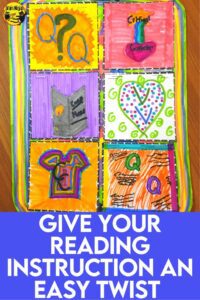
We want our students to enjoy a book, so using a book club is a great way to give students some control over their reading choices so they can enjoy it and talk about their reading more naturally.
Each time we do book clubs we give students a little more independence. During the first round, we usually choose the groups and the books (but we ask for student input). In the second round, we let students choose either books or group members. For the last round, students get to choose almost everything, unless we know they can’t handle all the choices on their own. In those cases, we try to support them as much as possible.
If you are looking for more reading about book clubs (or Literature Circles), be sure to read our post Using Book Clubs. We even have a digital version of Book Clubs called Using Google Hangouts to Run a Book Club.
You can of course run book clubs with a portion of your class while continuing more traditional Guided Reading sessions with the remainder of your class. This is one way you can differentiate for your more independent workers and readers.
How to Get Started With Literature Circles (or Book Clubs)
Gather Your Books
We try to keep sets of novels with about six to eight copies of each book. We’re fortunate that our school has a book room, but if yours doesn’t, start collecting titles–they don’t have to be exact copies. Some of our copies come through book sales and Scholastic book orders. It takes a long time to gather enough books for sets, so it might be worth your time to see if there is a way to start a book club collection in your school.
Set a Time Limit
Think about how long students will have to read their books (and then add two weeks). Students will need a bit of extra time to work on the assignments and do their reading. This gives students who read at a slower pace the opportunity to keep up or catch up with their group. Students who finish their books quickly still have to meet with their group, so those students are encouraged to pace themselves.
Host a Book Tasting
One morning we host a bit of a “book tasting.” We do a small book talk on each of the possible books and then let students explore all the different books. Students feel like they’ve made the choice for the book, but we influenced the reading level or topic based on student needs. We, of course, encourage students to read a page or two to decide if the book is right for them.
Students are asked to take a look at all the books and write their first, second, and third choices on an index card. We collect those cards and then make the book clubs based on what books students would like, their reading level, and student personalities in groups so they can work well together.
Group Your Students
Once the groups are set (usually 4-5 students), students meet with their groups along with the new books. They are asked to make a schedule for reading. We give students the due date for the entire book club, including any written work.
Explain the Assignments to Students
We recommend before sending your students off into groups with the assignments, use the “apps” as a class for your read-aloud. Read a chapter to your class and then teach your students one of the different “apps” from the Twisted Literature Circles package. Each day you can teach and model a different “app” until you have taught all of them to the class. You can find this Twisted Lit Circles activity in our TPT Store and BN Shop.
Sign the Contracts
We ask students to fill out a simple contract with each other and with us. They hand in this contract and we put it in a page protector and hang it up on our book club bulletin board. You can get a copy of this contract in our Resource Library. Members of our email list get unlimited access to the library.
Organize the Materials
Each group has a book bag. This is where we keep their copies of the books, and each week, we put in the assignments for the groups. We also include a class list so the group member can keep track of who is handing in their assignments. These book bags are kept on a shelf in the classroom where the group leader can access them.
Based on the contracts, we print the right number of copies of the pages we need for the written assignments. We also keep a few extras of each page in a folder where students can access them if they need them.
What Teachers Do During the Sessions
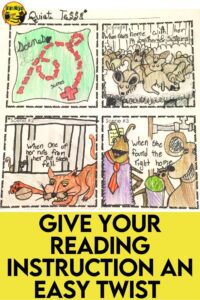
What We Do: Each week during our Guided Reading time (about 45 minutes a day), one group meets with us (the teacher) to talk about the book, and the other groups meet with each other, or they read and work on their assignments. During this time, we discuss the book. We check in with students to see how the book is working for them.
We go through a few pages with the group and check vocabulary and understanding. Sometimes we’ll just ask simple questions about the book, such as, who is your favourite character so far? Why?
The idea is to show students how to have a discussion about a book. We want to teach students to talk about books as if they are discussing them with a friend. We try to model questions that other readers would ask, not just teacher-like questions.
When there is enough time, we read with students (or have them read to us). This is a great time to check for comprehension. We also listen for fluency and whether or not students are able to read the punctuation and phrasing based on the author’s intent. Make notes of how your students have read. Book clubs or literature circles take a few weeks, and that’s a lot of time to go with doing some assessment of reading.
What if I can’t read the whole book?
Often we do not have time to read the whole book, so if that happens to you, check out GoodReads.com, as they often have summaries that you can read. Individuals might also have written summaries, so you can sometimes get a pretty good overview of a book.
When you’re asking questions, keep them big. For example, you could use any of these questions, and the students don’t need to know that you don’t know the whole book:
- what has surprised you the most about this book so far?
- if you were the author, what would you change?
- who is your favourite character and why?
- what do you think will happen next and give me the evidence based on what you’ve read so far.
- is this book like any other book you’ve read, how or why not?
- what do you think the author is trying to teach you in this book?
- what is the character ____________ like? Give me some character traits that describe him/her.
What written tasks should I assign?
We get the writing tasks organized. We use our Twisted Literature Circles package. There are several assignments that end up creating a final project that looks like an iPad covered in apps. Some of the possible apps include skills for summarizing, retelling, character study, and story timelines.
If you are looking for more writing activities, read our post Challenge Your Students with Writing Activities Every Day.
What Students Do During the Sessions
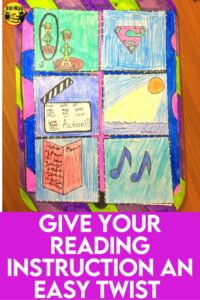
Students are expected to read their books according to the schedule the group has created. We prefer for students to spend the majority of their time reading, but some students need to take the book home to do a bit of reading at home to keep up with the group.
Each week, students complete one assignment from the Twisted Literature Circles package. We select the available assignments students can do, and they choose which one they do each week. The six assignments create an iPad-styled group of apps that students love. Students love the chance to be creative. You can find the Twisted Lit Circles activity in our TPT Store and BN Shop.
The amount of writing is kept to a minimum because there isn’t much room to write (that’s on purpose). The focus keeps students on task, and for many, it lowers the anxiety about having to do a huge assignment.
What Students Say About the Twisted Literature Circles Activities
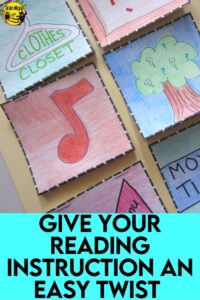
Generally, students enjoy the Twisted Literature Circles assignments more than traditional “roles” often used. The writing is significantly less, but the creativity needed makes it impossible for students to get through the assignments without having read the book.
We asked our students to give us a few statements about what they liked about the assignments. Here is some of their feedback:
- I liked making my iPad.
- Usually I can’t get all my work done because I read slower. This was good because there wasn’t too much writing and I had enough time to get my part done for the group.
- Can we do this again with our own books?
- I really liked the ones when we got to draw.
- I liked that I got to pick the ones I wanted to do.
Are you looking for another way for students to share what they are reading? Pick up this Home Reading Challenge in our Resource Library. Or, we can send it directly to your inbox when you join our email list. It is also available in French in our Resource Library.
Are you looking for more ideas for integrating reading in your classroom?
- How to Set Up Your Reading Comprehension Schedule
- Add Great Content to Your Literacy Lessons
- Preparing for Guided Reading Groups
- Practical Strategies for Reluctant Readers
- How to Teach Reading With Book Clubs
- How to Use Google Meet to Run a Book Club
- How to Celebrate Poem in Your Pocket Day
- Help! I Don’t Know How to do Guided Reading
- Help! What do the Other Kids do During Guided Reading?
- How to Run Your Guided Reading Instruction
- How to Include Different Types of Writing in Your Classroom
What types of activities do you do with your class involving novel studies? Have you tried Twisted Literature Circles? Book clubs? Tell us about your successes or challenges in the comments below. We’d love to hear from you.

